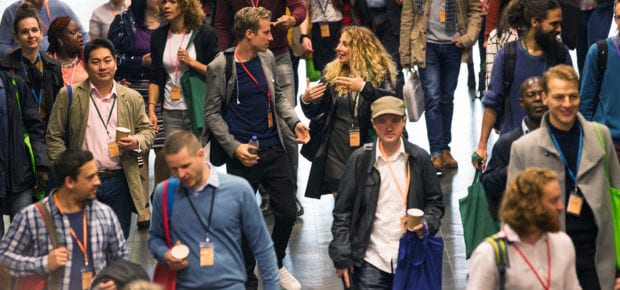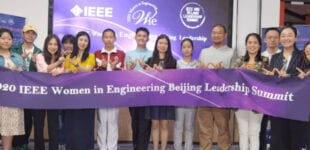March 13, 2019
Over 100,000 people and 2,400 companies attended this year’s Mobile World Congress (MWC) in Barcelona, making it the largest mobile event in the world. Delegates came from all sectors: makers of the cellular base stations that transmit phone signals, producers of the mobile devices that receive them, cloud service providers, developers and more.
One of the most prominent speakers was Microsoft CEO Satya Nadella, who outlined his vision of a connected world of built-in intelligence: “Computing is no longer confined to a device or even a single data center. Instead it is ubiquitous fabric, it is distributed from the cloud to the edge, closer to where data is generated, and with the ability to adapt to the wide range of inputs, whether it’s touch, speech, vision or gestures.” This connectivity will enable people with world-changing vision to have a greater impact.
5G
The main takeaway for most attendees was that 5G has arrived; it seemed to be everywhere. There were numerous demonstrations of super-fast speeds over 1 Gbps. My favorite was by Santiago Tenorio, head of network strategy and architecture at Vodafone, who showed a 5G connection to a car at a bandwidth of 1,500 Mbps. He also zoomed in to show the network’s 5G notification on the top left of the phone. That was the first time many people had ever seen that notification.
All the major mobile telecommunications players are rolling out 5G. Samsung showcased its next generation 5G Radio Frequency (RF) chipsets, which are 25% smaller, lighter and less power consuming than previous iterations. LG Uplus announced it has built a 5G commercial network and demonstrated enhanced mobile broadband (eMBB) applications such as virtual reality gaming on 5G terminals and a 5G HD live video broadcast.
Nokia forecasted the rise of private LTE networks in campuses, industrial areas and mines – areas where IEEE 802.11 is not strong, so LTE and 5G connectivity are needed to control intelligent systems. They also claimed that the US market is ahead of the pack on 5G, followed by Japan, Korea, Australia and the Middle East.
5G & Foldable phones
5G isn’t going to disrupt society without the necessary compatible phones. More than 40 vendors have launched them, but the star of the show was the Huawei Mate X 5G folding phone. It comes with a 6.6-inch front screen and a 6.38-inch rear screen. When fully unfolded, it turns in to an 8-inch tablet with 2,480 x 2,200-pixel resolution. It looked sleek, and the screen showed no visible seam. It really did wow attendees.
Make no mistake, the Huawei Mate X is a premium phone – it costs $2,600. Other options on display like the Samsung Galaxy Fold ($1,980) and the Royole FlexPai ($1,700) were not inexpensive, either. With these phones, it’s worth pointing out that the huge bandwidth and low latency features of the 5G network will make video calls outstanding.
IOT
The Internet of Things (IoT) was also a dominant theme at MWC. I think I saw every household device in existence on display as an IoT device.
Of course, connecting everything requires bandwidth. Vodafone and Arm announced a partnership to simplify the deployment of IoT devices, claiming to reduce the cost of connectivity by 50%. Vodafone will provide the same connectivity that a SIM card provides, but place it directly onto the processor’s silicon using integrated SIM (iSIM) technology. Phil Skipper, head of business development at Vodafone, said “Cutting out the need for a physical connectivity card cuts costs dramatically, primarily in the supply chain, and these savings will be largely seen in the IoT industry.”
Virtual Reality (VR) & Augmented Reality (AR)
The main announcement in this area was the Microsoft HoloLens 2, an updated version of their mixed reality headset. It features a more comfortable design with improved optics that track where the user’s eyes are looking. This should lead to a more reactive, immersive augmented reality experience. It’s expensive, but seems to address the main weakness of the first version, which was the poor field of view: this version allows users to read 8-point font on web pages.
VR and AR are expected to greatly benefit from 5G’s increased bandwidth, so it was interesting to see leading mobile chip makers pushing for a diverse array of devices compatible with Android phones. Qualcomm revealed a platform for smartphone-powered virtual and augmented reality headsets that rely on 5G networks. These viewers are capable of running apps through a phone over a USB-C cable, combining the benefits of both tethered and mobile headsets.
On the whole, Mobile World Congress maintained its position as one of the most important technological events of the year. The foldable phones were the first true innovation in smartphones for many years, but the clear arrival of 5G phones and 5G network deployments is what has really lingered in my mind.
About the author: IEEE Senior Member Kevin Curran is a Professor of Cyber Security, Executive Co-Director of the Legal innovation Centre and group leader of the Ambient Intelligence and Virtual Worlds Research Group at Ulster University. Curran is perhaps most well-known for his work on cyber security, blockchain and location positioning within indoor environments evidenced by over 800 peer reviewed papers. He is one of the most interviewed technology experts in the UK, with over 1000+ interviews in recent years https://kevincurran.org/interviews/.






 Meaningful Momentum or Running in Place?
Meaningful Momentum or Running in Place? AI Through Our Ages
AI Through Our Ages Liquid Infrastructure: Our Planet's Most Precious Resource
Liquid Infrastructure: Our Planet's Most Precious Resource The Impact of Technology in 2025
The Impact of Technology in 2025 Quantum and AI: Safeguards or Threats to Cybersecurity?
Quantum and AI: Safeguards or Threats to Cybersecurity? Why AI Can't Live Without Us
Why AI Can't Live Without Us Bits, Bytes, Buildings and Bridges: Digital-Driven Infrastructure
Bits, Bytes, Buildings and Bridges: Digital-Driven Infrastructure Impact of Technology in 2024
Impact of Technology in 2024 Emerging AI Cybersecurity Challenges and Solutions
Emerging AI Cybersecurity Challenges and Solutions The Skies are Unlimited
The Skies are Unlimited Smart Cities 2030: How Tech is Reshaping Urbanscapes
Smart Cities 2030: How Tech is Reshaping Urbanscapes Impact of Technology 2023
Impact of Technology 2023 Cybersecurity for Life-Changing Innovations
Cybersecurity for Life-Changing Innovations Smarter Wearables Healthier Life
Smarter Wearables Healthier Life Infrastructure In Motion
Infrastructure In Motion The Impact of Tech in 2022 and Beyond
The Impact of Tech in 2022 and Beyond Cybersecurity, Technology and Protecting Our World
Cybersecurity, Technology and Protecting Our World How Technology Helps us Understand Our Health and Wellness
How Technology Helps us Understand Our Health and Wellness The Resilience of Humanity
The Resilience of Humanity Harnessing and Sustaining our Natural Resources
Harnessing and Sustaining our Natural Resources Creating Healthy Spaces Through Technology
Creating Healthy Spaces Through Technology Exceptional Infrastructure Challenges, Technology and Humanity
Exceptional Infrastructure Challenges, Technology and Humanity The Global Impact of IEEE's 802 Standards
The Global Impact of IEEE's 802 Standards Scenes of our Cyber Lives: The Security Threats and Technology Solutions Protecting Us
Scenes of our Cyber Lives: The Security Threats and Technology Solutions Protecting Us How Millennial Parents are Embracing Health and Wellness Technologies for Their Generation Alpha Kids
How Millennial Parents are Embracing Health and Wellness Technologies for Their Generation Alpha Kids Space Exploration, Technology and Our Lives
Space Exploration, Technology and Our Lives Global Innovation and the Environment
Global Innovation and the Environment How Technology, Privacy and Security are Changing Each Other (And Us)
How Technology, Privacy and Security are Changing Each Other (And Us) Find us in booth 31506, LVCC South Hall 3 and experience the Technology Moon Walk
Find us in booth 31506, LVCC South Hall 3 and experience the Technology Moon Walk Virtual and Mixed Reality
Virtual and Mixed Reality How Robots are Improving our Health
How Robots are Improving our Health IEEE Experts and the Robots They are Teaching
IEEE Experts and the Robots They are Teaching See how millennial parents around the world see AI impacting the lives of their tech-infused offspring
See how millennial parents around the world see AI impacting the lives of their tech-infused offspring Take the journey from farm to table and learn how IoT will help us reach the rising demand for food production
Take the journey from farm to table and learn how IoT will help us reach the rising demand for food production Watch technical experts discuss the latest cyber threats
Watch technical experts discuss the latest cyber threats Explore how researchers, teachers, explorers, healthcare and medical professionals use immersive technologies
Explore how researchers, teachers, explorers, healthcare and medical professionals use immersive technologies Follow the timeline to see how Generation AI will be impacted by technology
Follow the timeline to see how Generation AI will be impacted by technology Learn how your IoT data can be used by experiencing a day in a connected life
Learn how your IoT data can be used by experiencing a day in a connected life Listen to technical experts discuss the biggest security threats today
Listen to technical experts discuss the biggest security threats today See how tech has influenced and evolved with the Games
See how tech has influenced and evolved with the Games Enter our virtual home to explore the IoT (Internet of Things) technologies
Enter our virtual home to explore the IoT (Internet of Things) technologies Explore an interactive map showcasing exciting innovations in robotics
Explore an interactive map showcasing exciting innovations in robotics Interactively explore A.I. in recent Hollywood movies
Interactively explore A.I. in recent Hollywood movies Get immersed in technologies that will improve patients' lives
Get immersed in technologies that will improve patients' lives